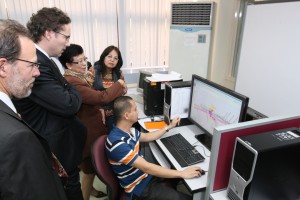
MANILA – The “ Enhanced Tropical Cyclone Early Warning System” was finally launched Friday at the Weather and Flood Forecasting Center, Philippine Atmospheric Geophysical and Astronomical Services Administration (PAGASA) compound in Quezon City. The module was developed with support from the Australian Bureau of Meteorology through the Php 17 million grant from the Australian Government Aid Program.
Australian Ambassador Rod Smith, Department of Science and Technology Secretary Estrella Alabastro, PAGASA Deputy Administrator Dr. Nathaniel Servando and Australian Bureau of Meteorology representative Todd Smith led the press briefng. “The launching is very timely in the enhancement of forecasting system in PAGASA especially with the passage of 19th tropical cyclone Santi in the Philipine Area of Responsibility,” Servando said.
Strengthening regional and global cooperation
Rod Smith said, the early warning system seeks to provide wider cooperation within the Asia-Pacific region underscoring the need to increase cooperation when it comes to climate change management and mitigation through the regional and wider global cooperation between government and technical agencies from different countries.
PAGASA has been getting experts from Australia to complete the module the past year. The system was developed for 8 years by the Australian Meteorological Institute and customized to the Philippine setting for 1 year. There are eight forecasting models being used prior to the model. “The model is capable of consolidating 13 or more forecasting models in the system,” Todd Smith noted while showing how the system works. “The more forecasting models, the better is the accuracy of the forecast.”
The agency is mandated to come up with 6 advisories everyday by comparing all the forecasting models before finally comparing it to their own forecast. “ The module will allow us to have easier forecast by providing the consensus of all the other forecasts,” Alabastro said. He noted that the automated forecasting model will also increase the forecast accuracy to 15% because human error in plotting and comparing manually will be avoided.
The need to address the communities’ vulnerabilities
Todd Smith emphasized the need to reduce the vulnerability of the people. In his presentation, he showed how the three factors affect the vulnerability of the communities, namely, frequency of hazard, exposure of the communities to these hazards, and ability of the community to mitigate the impact associated with these disasters
By enhancing the ability of communities to better prepare for disasters by raising their awareness through educational campaigns, trainings, early warning system and contingency plans, their vulnerabilities will be greatly reduced.
Australia has been supporting the Philippines on disaster related activities including strengthening community-based disaster management and has provided approximately Php 230 million in humanitarian and emergency assistance in response to natural disasters in the country since 2006.
How the system works
Through the model, the data will be simulated by drawing a consensus out of the different forecasts from around the globe, showing a real-time data imagery of provinces at risk, typhoon tracks and the uncertainties associated with it.
The tool has the capability to assimilate large quantity of data and transform it to real-time data imagery for easier and better analysis. By reducing the time to prepare the forecast from less than an hour to a minute of preparation, there will be faster delivery of warnings through an automated delivery system for fax, e-mail, internet and sms.
The model is expected to improve the tracking and accuracy of tropical cyclone forecasting including the position and intensity of a storm. The system also allows the validation of forecasts every after event to continuously improve its accuracy .
“The aim of this early warning system is to strengthen the ability of PAGASA to bring wide array of information regarding the Tropical Cyclones,” Rod Smith said. “This will enhance its capability to provide immediate warnings to communities and understand the nature of these disasters by taking advantage of the technology,” he added during the briefing.

Leave a Reply